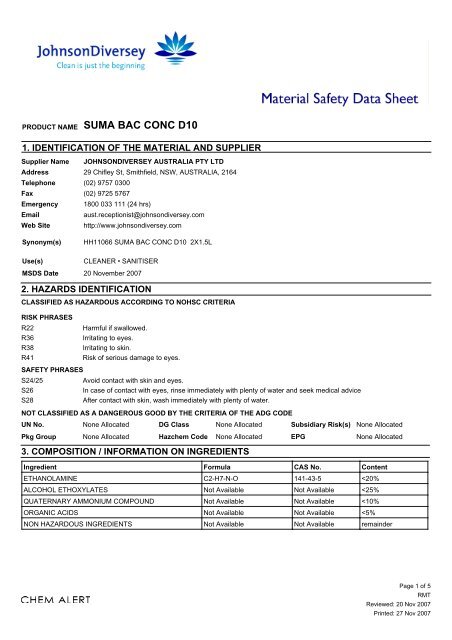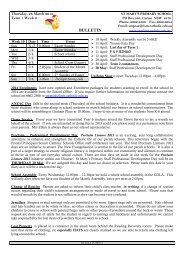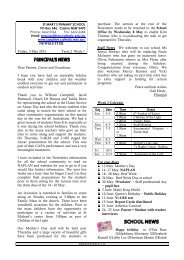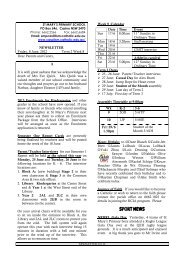SUMA BAC CONC D10
SUMA BAC CONC D10
SUMA BAC CONC D10
Create successful ePaper yourself
Turn your PDF publications into a flip-book with our unique Google optimized e-Paper software.
PRODUCT NAME<br />
1. IDENTIFICATION OF THE MATERIAL AND SUPPLIER<br />
Supplier Name JOHNSONDIVERSEY AUSTRALIA PTY LTD<br />
Address<br />
Telephone<br />
Emergency<br />
Email<br />
29 Chifley St, Smithfield, NSW, AUSTRALIA, 2164<br />
(02) 9757 0300<br />
Fax (02) 9725 5767<br />
Web Site<br />
Use(s)<br />
<strong>SUMA</strong> <strong>BAC</strong> <strong>CONC</strong> <strong>D10</strong><br />
1800 033 111 (24 hrs)<br />
aust.receptionist@johnsondiversey.com<br />
http://www.johnsondiversey.com<br />
Synonym(s) HH11066 <strong>SUMA</strong> <strong>BAC</strong> <strong>CONC</strong> <strong>D10</strong> 2X1.5L<br />
CLEANER • SANITISER<br />
MSDS Date 20 November 2007<br />
2. HAZARDS IDENTIFICATION<br />
CLASSIFIED AS HAZARDOUS ACCORDING TO NOHSC CRITERIA<br />
RISK PHRASES<br />
R22 Harmful if swallowed.<br />
R36 Irritating to eyes.<br />
R38 Irritating to skin.<br />
R41 Risk of serious damage to eyes.<br />
SAFETY PHRASES<br />
S24/25 Avoid contact with skin and eyes.<br />
S26 In case of contact with eyes, rinse immediately with plenty of water and seek medical advice<br />
S28 After contact with skin, wash immediately with plenty of water.<br />
NOT CLASSIFIED AS A DANGEROUS GOOD BY THE CRITERIA OF THE ADG CODE<br />
UN No.<br />
Pkg Group<br />
None Allocated DG Class None Allocated Subsidiary Risk(s) None Allocated<br />
None Allocated Hazchem Code None Allocated EPG<br />
None Allocated<br />
3. COMPOSITION / INFORMATION ON INGREDIENTS<br />
Ingredient Formula CAS No. Content<br />
ETHANOLAMINE C2-H7-N-O 141-43-5
PRODUCT NAME <strong>SUMA</strong> <strong>BAC</strong> <strong>CONC</strong> <strong>D10</strong><br />
4. FIRST AID MEASURES<br />
Eye If in eyes, hold eyelids apart and flush the eye continuously with running water. Continue flushing until advised to<br />
stop by the PIC or a doctor, or for at least 15 minutes.<br />
Inhalation Leave area of exposure immediately. If other than minor symptoms occur, seek immediate medical attention. If<br />
assisting a victim avoid becoming a casualty, wear a Type A (Organic vapour) respirator. If victim is not breathing<br />
apply artificial respiration.<br />
Skin Remove contaminated clothing and gently flush affected areas with water. Seek medical attention if irritation<br />
develops. Launder clothing before reuse.<br />
Ingestion DO NOT induce vomiting. Immediately wash out mouth with water, and then give water to drink. Seek medical<br />
attention.<br />
Advice to Doctor The manufacturer recommends treating the patient symptomatically.<br />
First Aid Facilities Eye wash facilities and safety shower should be available.<br />
5. FIRE FIGHTING MEASURES<br />
Flammability Non flammable. May evolve toxic gases (carbon/ nitrogen oxides, hydrocarbons, amines, ammonia) when heated<br />
to decomposition.<br />
Fire and<br />
Explosion<br />
Non flammable. Evacuate area and contact emergency services. Toxic gases (carbon/ nitrogen oxides,<br />
hydrocarbons, ammonia, amines) may be evolved when heated. Remain upwind and notify those downwind of<br />
hazard. Wear full protective equipment (see spillage measures) including Self Contained Breathing Apparatus<br />
(SCBA) when combating fire. Use waterfog to cool intact containers and nearby storage areas.<br />
Extinguishing Non flammable. Prevent contamination of drains or waterways, absorb runoff with sand or similar.<br />
Hazchem Code None Allocated<br />
6. ACCIDENTAL RELEASE MEASURES<br />
Spillage If spilt (bulk), contact emergency services where appropriate. Wear splash-proof goggles, PVC/rubber gloves, a<br />
Type A (Organic vapour) respirator (where an inhalation risk exists), coveralls, PVC apron and rubber boots.<br />
Ventilate and clear area of all unprotected personnel. Absorb spill with sand or similar, collect and place in<br />
sealable containers for disposal.<br />
7. STORAGE AND HANDLING<br />
Storage<br />
Handling<br />
Store in cool, dry, well ventilated area, removed from oxidising agents, acids, nitrites - nitrosating agents and<br />
foodstuffs. Ensure containers are adequately labelled, protected from physical damage and sealed when not in<br />
use.<br />
Before use carefully read the product label. Use of safe work practices are recommended to avoid eye or skin<br />
contact and inhalation. Observe good personal hygiene, including washing hands before eating. Prohibit eating,<br />
drinking and smoking in contaminated areas.<br />
8. EXPOSURE CONTROLS / PERSONAL PROTECTION<br />
Exposure Stds<br />
Biological Limits<br />
Engineering<br />
Controls<br />
Ingredient Reference<br />
ppm<br />
TWA<br />
mg/m3 ppm<br />
STEL<br />
mg/m3<br />
Ethanolamine NOHSC (AUS) 3.0 7.5 6.0 15.0<br />
No biological limit allocated.<br />
Do not inhale vapours. Use in well ventilated areas. In poorly ventilated areas, mechanical extraction ventilation is<br />
recommended. Maintain vapour levels below the recommended exposure standard.<br />
PPE Wear splash-proof goggles, rubber or PVC gloves and coveralls. Where an inhalation risk exists, wear a Type A<br />
(Organic vapour) Respirator and an Air-line respirator.<br />
Page 2 of 5<br />
RMT<br />
Reviewed: 20 Nov 2007<br />
Printed: 27 Nov 2007
PRODUCT NAME <strong>SUMA</strong> <strong>BAC</strong> <strong>CONC</strong> <strong>D10</strong><br />
9. PHYSICAL AND CHEMICAL PROPERTIES<br />
Appearance CLEAR DARK PURPLE LIQUID Solubility (water) SOLUBLE<br />
Odour CHARACTERISTIC ODOUR Specific Gravity 1.04 (Approximately)<br />
pH 12.6 - 13.6 % Volatiles > 60 % (Water)<br />
Vapour Pressure 18 mm Hg @ 20°C Flammability NON FLAMMABLE<br />
Vapour Density NOT AVAILABLE Flash Point NOT RELEVANT<br />
Boiling Point 100°C Upper Explosion Limit NOT RELEVANT<br />
Melting Point < 0°C Lower Explosion Limit NOT RELEVANT<br />
Evaporation Rate AS FOR WATER Autoignition Temperature NOT AVAILABLE<br />
10. STABILITY AND REACTIVITY<br />
Chemical Stability Stable under recommended conditions of storage.<br />
Conditions to<br />
Avoid<br />
Avoid heat, sparks, open flames and other ignition sources.<br />
Material to Avoid May react with oxidising agents (eg. hypochlorites, peroxides), acids (eg. nitric acid) and nitrites (possibly forming<br />
carcinogenic nitrosamines).<br />
Decomposition May evolve toxic gases (carbon/ nitrogen oxides, hydrocarbons, amines, ammonia) when heated to<br />
decomposition.<br />
Hazardous<br />
Reactions<br />
Health Hazard<br />
Summary<br />
Polymerization is not expected to occur.<br />
11. TOXICOLOGICAL INFORMATION<br />
This product has the potential to cause acute and chronic health effects with over exposure. Use safe work<br />
practices to avoid eye and skin contact and vapour inhalation. Over exposure at high levels may result in corrosive<br />
tissue damage. Potential skin and respiratory sensitiser.<br />
Eye Exposure may result in pain, redness, corneal burns and ulceration with possible permanent damage with<br />
prolonged contact.<br />
Inhalation Over exposure may result in mucous membrane and upper respiratory tract irritation. May cause sensitisation with<br />
asthma-like symptoms. At high levels; breathing difficulties, ulceration of respiratory tract, pulmonary oedema and<br />
convulsions.<br />
Skin Contact may result in irritation, skin rash, dermatitis, sensitisation and burns. Toxic effects may result through skin<br />
absorption.<br />
Ingestion Ingestion may result in ulceration and burns to the mouth and throat, nausea, vomiting, abdominal pain and<br />
diarrhoea.<br />
Toxicity Data ETHANOLAMINE (141-43-5)<br />
LD50 (Ingestion): 620 mg/kg (guinea pig)<br />
LD50 (Skin): 1 mL/kg (rabbit)<br />
12. ECOLOGICAL INFORMATION<br />
Environment If released to the atmosphere ethanolamine is expected to exist almost entirely in the vapour phase. Expected to<br />
be removed by reaction with photochemically generated hydroxyl radicals and precipitation. If spilt on soil may<br />
leach into groundwater. Expected to biodegrade fairly rapidly following acclamation. Bioconcentration is not<br />
expected to be important fate processes. The surfactants used in this product are biodegradable.<br />
13. DISPOSAL CONSIDERATIONS<br />
Waste Disposal For small amounts, absorb with sand, vermiculite or similar and dispose of to an approved landfill site. For larger<br />
amounts, contact the manufacturer for additional information. Prevent contamination of drains or waterways as<br />
aquatic life may be threatened and environmental damage may result.<br />
Legislation Dispose of in accordance with relevant local legislation.<br />
14. TRANSPORT INFORMATION<br />
Page 3 of 5<br />
RMT<br />
Reviewed: 20 Nov 2007<br />
Printed: 27 Nov 2007
PRODUCT NAME <strong>SUMA</strong> <strong>BAC</strong> <strong>CONC</strong> <strong>D10</strong><br />
NOT CLASSIFIED AS A DANGEROUS GOOD BY THE CRITERIA OF THE ADG CODE<br />
Shipping Name<br />
UN No.<br />
Pkg Group<br />
None Allocated<br />
15. REGULATORY INFORMATION<br />
None Allocated DG Class None Allocated Subsidiary Risk(s) None Allocated<br />
None Allocated Hazchem Code None Allocated EPG<br />
None Allocated<br />
Poison Schedule Classified as a Schedule 5 (S5) Poison using the criteria in the Standard for the Uniform Scheduling of Drugs and<br />
Poisons (SUSDP).<br />
AICS All chemicals listed on the Australian Inventory of Chemical Substances (AICS).<br />
16. OTHER INFORMATION<br />
Additional<br />
Information<br />
The typical in-use concentration of 2%v/v of this solution is not classified as hazardous according to criteria of<br />
NOHSC Australia<br />
EXPOSURE STANDARDS - TIME WEIGHTED AVERAGES: Exposure standards are established on the premise<br />
of an 8 hour work period of normal intensity, under normal climatic conditions and where a 16 hour break between<br />
shifts exists to enable the body to eliminate absorbed contaminants. In the following circumstances, exposure<br />
standards must be reduced: strenuous work conditions; hot, humid climates; high altitude conditions; extended<br />
shifts (which increase the exposure period and shorten the period of recuperation).<br />
RESPIRATORS: In general the use of respirators should be limited and engineering controls employed to avoid<br />
exposure. If respiratory equipment must be worn ensure correct respirator selection and training is undertaken.<br />
Remember that some respirators may be extremely uncomfortable when used for long periods. The use of air<br />
powered or air supplied respirators should be considered where prolonged or repeated use is necessary.<br />
ABBREVIATIONS:<br />
ADB - Air-Dry Basis.<br />
BEI - Biological Exposure Indice(s)<br />
CAS# - Chemical Abstract Service number - used to uniquely identify chemical compounds.<br />
CNS - Central Nervous System.<br />
IARC - International Agency for Research on Cancer.<br />
M - moles per litre, a unit of concentration.<br />
mg/m3 - Milligrams per cubic metre.<br />
NOS - Not Otherwise Specified.<br />
pH - relates to hydrogen ion concentration using a scale of 0 (high acidic) to 14 (highly alkaline).<br />
ppm - Parts Per Million.<br />
TWA/ES - Time Weighted Average or Exposure Standard.<br />
HEALTH EFFECTS FROM EXPOSURE:<br />
It should be noted that the effects from exposure to this product will depend on several factors including: frequency<br />
and duration of use; quantity used; effectiveness of control measures; protective equipment used and method of<br />
application. Given that it is impractical to prepare a Chem Alert report which would encompass all possible<br />
scenarios, it is anticipated that users will assess the risks and apply control methods where appropriate.<br />
PERSONAL PROTECTIVE EQUIPMENT GUIDELINES:<br />
The recommendation for protective equipment contained within this Chem Alert report is provided as a guide only.<br />
Factors such as method of application, working environment, quantity used, product concentration and the<br />
availability of engineering controls should be considered before final selection of personal protective equipment is<br />
made.<br />
Report Status This document has been compiled by RMT on behalf of the manufacturer of the product and serves as the<br />
manufacturer's Material Safety Data Sheet ('MSDS').<br />
It is based on information concerning the product which has been provided to RMT by the manufacturer or<br />
obtained from third party sources and is believed to represent the current state of knowledge as to the appropriate<br />
safety and handling precautions for the product at the time of issue. Further clarification regarding any aspect of<br />
the product should be obtained directly from the manufacturer.<br />
While RMT has taken all due care to include accurate and up-to-date information in this MSDS, it does not provide<br />
any warranty as to accuracy or completeness. As far as lawfully possible, RMT accepts no liability for any loss,<br />
injury or damage (including consequential loss) which may be suffered or incurred by any person as a<br />
consequence of their reliance on the information contained in this MSDS.<br />
Prepared By Risk Management Technologies<br />
Page 4 of 5<br />
RMT<br />
Reviewed: 20 Nov 2007<br />
Printed: 27 Nov 2007
PRODUCT NAME <strong>SUMA</strong> <strong>BAC</strong> <strong>CONC</strong> <strong>D10</strong><br />
5 Ventnor Ave, West Perth<br />
Western Australia 6005<br />
Phone: +61 8 9322 1711<br />
Fax: +61 8 9322 1794<br />
Email: info@rmt.com.au<br />
Web: www.rmt.com.au<br />
MSDS Date: 20 November 2007<br />
End of Report<br />
Page 5 of 5<br />
RMT<br />
Reviewed: 20 Nov 2007<br />
Printed: 27 Nov 2007

















